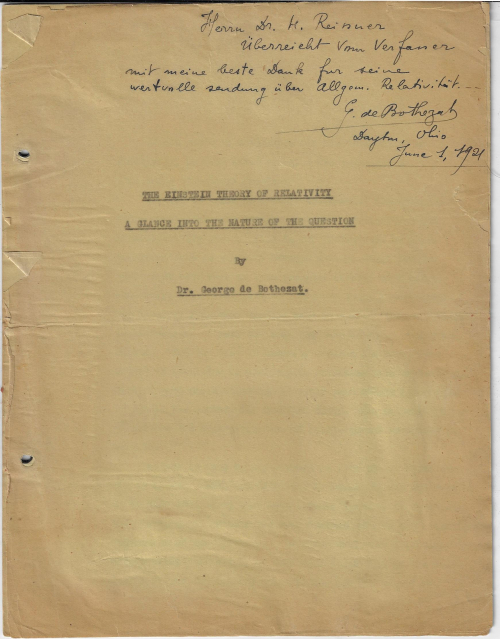George de Bothezat (1882-1940) The Einstein Theory of Relativity, a Glance into the Nature of the Question. Carbon copy from typed sheets, I believe, 1921. 11x8, 12 leaves. The leaves seem to be glued together as a binding along the left edge of the sheets; the cover is present but detached, or loose. There are also two punch holes for binding. I can find only one listing for this 1921 work in WorldCat/OCLC. $450
 Presentation copy to Prof. Hans J. Reissner (Reissner-Nordstrom metric among much else)--I imagine that de Bothezat would have been well familiar with the early flight engineering work of Reissner as well as his terrific contribution on the Einstein metric. Condition: a good copy, with perhaps either some damp staining that led to some pressure marks in the paper, or perhaps these were just pressure marks, from pressure. In any event, the paper it was printed on was inferior even when new, and so it has browning and is brittle here and there. Apart from the general history of the theory de Bothezat seems to be very uneasy with Einstein in this paper, and I cannot find any mention of it in the usual Einstein sources. In any event, it is a very scarce thing. (A 7pp paper by this name of was published in the journal The New World in November, 1930, pp 105-112, but I cannot locate a copy to compare the two efforts. de Bothezat would return later to Einstein in a book titled Back to Newton..., in which he refutes the theory of relativity (and a lot of modern physics). Oh, well.
Presentation copy to Prof. Hans J. Reissner (Reissner-Nordstrom metric among much else)--I imagine that de Bothezat would have been well familiar with the early flight engineering work of Reissner as well as his terrific contribution on the Einstein metric. Condition: a good copy, with perhaps either some damp staining that led to some pressure marks in the paper, or perhaps these were just pressure marks, from pressure. In any event, the paper it was printed on was inferior even when new, and so it has browning and is brittle here and there. Apart from the general history of the theory de Bothezat seems to be very uneasy with Einstein in this paper, and I cannot find any mention of it in the usual Einstein sources. In any event, it is a very scarce thing. (A 7pp paper by this name of was published in the journal The New World in November, 1930, pp 105-112, but I cannot locate a copy to compare the two efforts. de Bothezat would return later to Einstein in a book titled Back to Newton..., in which he refutes the theory of relativity (and a lot of modern physics). Oh, well.
- George Bothezat (1882-1940) was a Russian-American engineer, mostly remembered today for his early engineering work on helicopters and aerodynamics. “In May 1918, with his homeland in the throes of the Russian Revolution, de Bothezat fled from the Bolsheviks to the United States. In June 1918, he was hired by the National Advisory Committee for Aeronautics. He lectured at the Massachusetts Institute of Technology and the Columbia University. ...In 1921, the US Army Air Service hired de Bothezat to build a prototype helicopter. The quadrotor helicopter, known simply as the de Bothezat helicopter, was built by de Bothezat and Ivan Jerome in the hangars of Wright Field near Dayton, Ohio. The first flight turned out to be surprisingly successful for a machine that had been built without prototyping. In 1922, their "flying octopus" flew many times, although slowly and at low altitudes. In fact, its horizontal motion was induced by wind more than by the pilot's controls. The Army, now more interested in autogyros, cancelled the underperforming project.”--Wiki
- “Hans J. Reissner (1874-1967) was a leading German pioneer in aeronautics and aeronautical engineering and mathematical physics. He was appointed to the chair vacated by Arnold Sommerfeld at the Technische Hochschul at Aachen, where he established the aerodynamics laboratory and designed the great experimental wind tunnel at Aachen where he was the second director (after T. von Karman). He went on to the University of Berlin where he remained until 1938, when he left Germany for the United States. Reissner held a chair at the Illinois Institute of Technology and in 1944 joined the faculty at Brooklyn Polytechnic Institute. Van Karman spoke very highly of Reissner and attributed his work in aerodynamics to be as important as those advances made by Prandtl (see von Karman’s Wind and Beyond). Reissner was also celebrated with two anniversary volumes of Applied Mathematiics for his 60th and 75th birthdays (in 1934 and 1949).”
Also see: Michael J. Hirschberg, "A Perspective on the First Century of Vertical Flight", SAE International website.



Comments